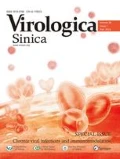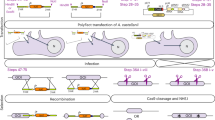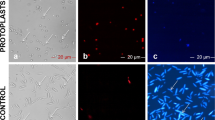Abstract
Mycoviruses have been found to infect more than 12 species of Penicillium, but have not been isolated from Penicillium italicum (P. italicum). In this study, we isolated and characterized a new double-stranded RNA (dsRNA) virus, designated Penicillium italicum chrysovirus 1 (PiCV1), from the citrus pathogen P. italicum HSPi-YN1. Viral genome sequencing and molecular characterization indicated that PiCV1 was highly homologous to the previously described Penicillium chrysogenum virus. We further constructed the mutant HSPi-YN1ΔpksP defective in the polyketide synthase gene (pksP), which is involved in pigment biosynthesis, and these mutants formed albino (white) colonies. Then we applied hyphal anastomosis method to horizontally transmit PiCV1 from the white virus-donors (i.e., HSPi-YN1 mutants) to wild-type recipients (i.e., P. italicum strains HSPi-CQ54, HSPi-HB4, and HSPi-HN1), and the desirable PiCV1-infected isogenic recipients, a certain part of blue wild-type strains, can be eventually selected and confirmed by viral genomic dsRNA profile analysis. This blue-white colony screening would be an easier method to select virus-infected P. italicum recipients, according to distinguishable color phenotypes between blue virus-recipients and white virus-donors. In summary, the current work newly isolated and characterized PiCV1, verified its horizontal transmission among dually cultured P. italicum isolates, and based on these, established an effective and simplified approach to screen PiCV1-infected isogenic recipients.







Similar content being viewed by others
References
Aihara M, Urayama SI, Le MT, Katoh Y, Higashiura T, Fukuhara T, Arie T, Teraoka T, Komatsu K, Moriyama H (2018) Infection by Magnaporthe oryzae chrysovirus 1 strain A triggers reduced virulence and pathogenic race conversion of it host fungus, Magnaporthe oryzae. J Gen Plant Pathol 84:92–103
Banks GT, Buck KW, Chain EB, Darbyshire JE, Himmelweit F (1969) Penicillium cyaneo-fulvumvirus and interferon stimulation. Nature 223:155–158
Border DJ, Buck KW, Chain EB, Kempson-Jones GF, Lhoas P, Ratti G (1972) Viruses of Penicillium and Aspergillus species. Biochem J 127:4P
Borré E, Morgantini LE, Ortali V, Tonolo A (1971) Production of lytic plaques of viral origin in Penicillium. Nature 229:568
Boubaker H, Saadi B, Boudyach EH, Benaoumar AA (2009) Sensitivity of Penicillium digitatum and P. italicum to imazalil and thiabendazole in Morocco. Plant Pathol J 8:152–158
Castón JR, Ghabrial SA, Jiang D, Rivas G, Alfonso C, Roca R, Luque D, Carrascosa JL (2003) Three-dimensional structure of Penicillium chrysogenum virus: a double-stranded RNA virus with a genuine T = 1 capsid. J Mol Biol 331:417–431
Coenen A, Kevei F, Hoekstra RF (1997) Factors affecting the spread of double-stranded RNA viruses in Aspergillus nidulans. Genet Res 69:1–10
Ellis LF, Kleinschmidt WJ (1967) Virus-like particles of a fraction of statolon, a mould product. Nature 215:649
Gallie DR, Walbot V (1992) Identification of the motifs within the tobacco mosaic virus 5′-leader responsible for enhancing translation. Nucl Acids Res 20:4631–4638
Ghabrial SA, Suzuki N (2009) Viruses of plant pathogenic fungi. Annu Rev Phytopathol 47:353–384
Ghabrial SA, Castón JR, Coutts RH, Hillman BI, Jiang D, Kim DH, Moriyama H (2018) ICTV virus taxonomy profile: chrysoviridae. J Gen Virol 99:19–20
Hillman BI, Supyani S, Kondo H, Suzuki N (2004) A reovirus of the fungus Cryphonectria parasitica that is infectious as particles and related to the Coltivirus genus of animal pathogens. J Virol 78:892–898
Hollings M (1962) Viruses associated with a die-back disease of cultivated mushroom. Nature 196:962
Jamal A, Bignell EM, Coutts RH (2010) Complete nucleotide sequences of four dsRNAs associated with a new chrysovirus infecting Aspergillus fumigatus. Virus Res 153:64–70
Jiang D, Ghabrial SA (2004) Molecular characterization of Penicillium chrysogenum virus: reconsideration of the taxonomy of the genus Chrysovirus. J Gen Virol 85:2111–2121
Kim JW, Kim SY, Kim KM (2003) Genome organization and expression of the Penicillium stoloniferum virus S. Virus Genes 27:249–256
Kim JM, Jung JE, Park JA, Park SM, Cha BJ, Kim DH (2013) Biological function of a novel chrysovirus, CnV1-BS122, in the Korean Cryphonectria nitschkei BS122 strain. J Biosci Bioeng 115:1–3
Korsten L (2006) Advances in control of postharvest diseases in tropical fresh produce. Int J Postharvest Technol Innov 1:48–61
Lee KM, Yu J, Son M, Lee YW, Kim KH (2011) Transmission of Fusarium boothii mycovirus via protoplast fusion causes hypovirulence in other phytopathogenic fungi. PLoS ONE 6:e21629
Lee KM, Cho WK, Yu J, Son M, Choi H, Min K, Lee YW, Kim KH (2014) A comparison of transcriptional patterns and mycological phenotypes following infection of Fusarium graminearum by four mycoviruses. PLoS ONE 9:e100989
Li L, Liu J, Xu A, Wang T, Chen J, Zhu X (2013) Molecular characterization of a trisegmented chrysovirus isolated from the radish Raphanus sativus. Virus Res 176:169–178
Liu YC, Linder-Basso D, Hillman BI, Kaneko S, Milgroom MG (2003) Evidence for interspecies transmission of viruses in natural populations of filamentous fungi in the genus Cryphonectria. Mol Ecol 12:1619–1628
Liu H, Fu Y, Jiang D, Li G, Xie J, Peng Y, Yi X, Ghabrial SA (2009) A novel mycovirus that is related to the human pathogen hepatitis E virus and rubi-like viruses. J Virol 83:1981–1991
Liu J, Yuan Y, Wu Z, Li N, Chen Y, Qin T, Geng H, Xiong L, Liu D (2015) A novel sterol regulatory element-binding protein gene (sreA) identified in Penicillium digitatum is required for prochloraz resistance, full virulence and erg11 (cyp51) regulation. PLoS ONE 10:e0117115
Márquez LM, Redman RS, Rodriguez RJ, Roossinck MJ (2007) A virus in a fungus in a plant: three-way symbiosis required for thermal tolerance. Science 315:513–515
Melzer MS, Ikeda SS, Boland GJ (2002) Interspecific transmission of double-stranded RNA and hypovirulence from Sclerotinia sclerotiorum to S. minor. Phytopathology 92:780–784
Morris TJ, Dodds JA (1979) Isolation and analysis of double-stranded RNA from virus-infected plant and fungal tissue. Phytopathology 69:854–858
Nerva L, Ciuffo M, Vallino M, Margaria P, Varese GC, Gnavi G, Turina M (2016) Multiple approaches for the detection and characterization of viral and plasmid symbionts from a collection of marine fungi. Virus Res 219:22–38
Nerva L, Silvestri A, Ciuffo M, Palmano S, Varese GC, Turina M (2017) Transmission of Penicillium aurantiogriseum partiti-like virus 1 to a new fungal host (Cryphonectria parasitica) confers higher resistance to salinity and reveals adaptive genomic changes. Environ Microbiol 19:4480–4492
Niu Y, Zhang T, Zhu Y, Yuan Y, Wang S, Liu J, Liu D (2016) Isolation and characterization of a novel mycovirus from Penicillium digitatum. Virology 494:15–22
Niu Y, Yuan Y, Mao J, Yang Z, Cao Q, Zhang T, Wang S, Liu D (2018) Characterization of two novel mycoviruses from Penicillium digitatum and the related fungicide resistance analysis. Sci Rep 8:5513
Okada R, Ichinose S, Takeshita K, Urayama SI, Fukuhara T, Komatsu K, Arie T, Ishihara A, Egusa M, Kodama M, Moriyama H (2018) Molecular characterization of a novel mycovirus in Alternaria alternata manifesting two-sided effects: down-regulation of host growth and up-regulation of host plant pathogenicity. Virology 519:23–32
Pearson MN, Beever RE, Boine B, Arthur K (2009) Mycoviruses of filamentous fungi and their relevance to plant pathology. Mol Plant Pathol 10:115–128
Prusky D, McEvoy JL, Saftner R, Conway WS, Jones R (2004) Relationship between host acidification and virulence of Penicillium spp. on apple and citrus fruit. Phytopathology 94:44–51
Sasaki A, Kanematsu S, Onoue M, Oyama Y, Yoshida K (2006) Infection of Rosellinia necatrix with purified viral particles of a member of Partitiviridae (RnPV1-W8). Arch Virol 51:697–707
Sasaki A, Nakamura H, Suzuki N, Kanematsu S (2016) Characterization of a new megabirnavirus that confers hypovirulence with the aid of a co-infecting partitivirus to the host fungus, Rosellinia necatrix. Virus Res 219:73–82
Tamura K, Peterson D, Peterson N, Stecher G, Nei M, Kumar S (2011) MEGA5: molecular evolutionary genetics analysis using maximum likelihood, evolutionary distance, and maximum parsimony methods. Mol Biol Evol 28:2731–2739
Thompson JD, Gibson TJ, Plewniak F, Jeanmougin F, Higgins DG (1997) The CLUSTAL_X windows interface: flexible strategies for multiple sequence alignment aided by quality analysis tools. Nucl Acids Res 25:4876–4882
Urayama SI, Sakoda H, Takai R, Katoh Y, Le TM, Fukuhara T, Arie T, Teraoka T, Moriyama H (2014) A dsRNA mycovirus, Magnaporthe oryzae chrysovirus 1-B, suppresses vegetative growth and development of the rice blast fungus. Virology 448:265–273
Vainio EJ, Korhonen K, Tuomivirta TT, Hantula J (2010) A novel puta-tivepartitivirus of the saprotrophic fungus Heterobasidion ecrustosum infectspathogenic species of the Heterobasidion annosum complex. Fungal Biol 114:955–965
Wang J, Yu J, Liu J, Yuan Y, Li N, He M, Qi T, Geng H, Xiong L, Liu D (2014) Novel mutations in CYP51B from Penicillium digitatum involved in prochloraz resistance. J Microbiol 52:762–770
Wei CZ, Osaki H, Iwanami T, Matsumoto N, Ohtsu Y (2003) Molecular characterization of dsRNA segments 2 and 5 and electron microscopy of a novel reovirus from a hypovirulent isolate, W370, of the plant pathogen Rosellinia necatrix. J Gen Virol 84:2431–2437
Wood HA, Bozarth RF, Mislivec PB (1971) Viruslike particles associated with an isolate of Penicillium brevi-compactum. Virology 44:592–598
Wu M, Zhang L, Li G, Jiang D, Ghabrial SA (2010) Genome characterization of a debilitation-associated mitovirus infecting the phytopathogenic fungus Botrytis cinerea. Virology 406:117–126
Wu Z, Wang S, Yuan Y, Zhang T, Liu J, Liu D (2016) A novel major facilitator superfamily transporter in Penicillium digitatum (PdMFS2) is required for prochloraz resistance, conidiation and full virulence. Biotechnol Lett 38:1349–1357
Yang Z, Geng H, Zheng Y, Yuan Y, Wang M, Mao J, Zhang T, Niu Y, Liu D (2018) Molecular characterization of a new gammapartitivirus isolated from the citrus-pathogenic fungus Penicillium digitatum. Arch Virol 163:3185–3189
Yu X, Li B, Fu Y, Jiang D, Ghabrial SA, Li G, Peng Y, Xie J, Cheng J, Huang L, Yi X (2010) A geminivirus-related DNA mycovirus that confers hypovirulence to a plant pathogenic fungus. Proc Natl Acad Sci USA 107:8387–8392
Zerbino DR, Birney E (2008) Velvet: algorithms for de novo short read assembly using de Bruijn graphs. Genome Res 18:821–829
Zhang T, Jiang Y, Dong W (2014) A novel monopartite dsRNA virus isolated from the phytopathogenic fungus Ustilaginoidea virens and ancestrally related to a mitochondria-associated dsRNA in the green alga Bryopsis. Virology 462:227–235
Zhao S, Yan YS, He QP, Yang L, Yin X, Li CX, Mao LC, Liao LS, Huang JQ, Xie SB, Nong QD, Zhang Z, Jing L, Xiong YR, Duan CJ, Liu JL, Feng JX (2016) Comparative genomic, transcriptomic and secretomic profiling of Penicillium oxalicum HP7-1 and its cellulase and xylanase hyper-producing mutant EU2106, and identification of two novel regulatory genes of cellulase and xylanase gene expression. Biotechnol Biofuels 9:203
Acknowledgements
This work was supported by the National Natural Science Foundations of China (No. 31371893), the Natural Science Fund of Hubei Province (No. 2018CFB676) and the Project of Hubei Key Laboratory of Genetic Regulation and Integrative Biology (Grant No. GRIB20184).
Author information
Authors and Affiliations
Contributions
DL and YY conceived this study, acquired project funding, revised to complete final version of manuscript, and supervised all research activities. TZ and NL designed experiments and completed the data analysis. QC, YC, BT and GL performed most of the experiments. TZ wrote the paper draft. All authors read and approved the final manuscript.
Corresponding author
Ethics declarations
Conflict of interest
The authors declare that they have no competing interests.
Animal and Human Rights Statement
This article does not contain any studies with human or animal subjects performed by any of the authors.
Electronic supplementary material
Below is the link to the electronic supplementary material.
Rights and permissions
About this article
Cite this article
Zhang, T., Li, N., Yuan, Y. et al. Blue-White Colony Selection of Virus-Infected Isogenic Recipients Based on a Chrysovirus Isolated from Penicillium italicum. Virol. Sin. 34, 688–700 (2019). https://doi.org/10.1007/s12250-019-00150-z
Received:
Accepted:
Published:
Issue Date:
DOI: https://doi.org/10.1007/s12250-019-00150-z




